Explaining the demographic expansion of the Ancient Greeks (550-409 BCE) through the lens of the city of Himera (Sicily, Italy)
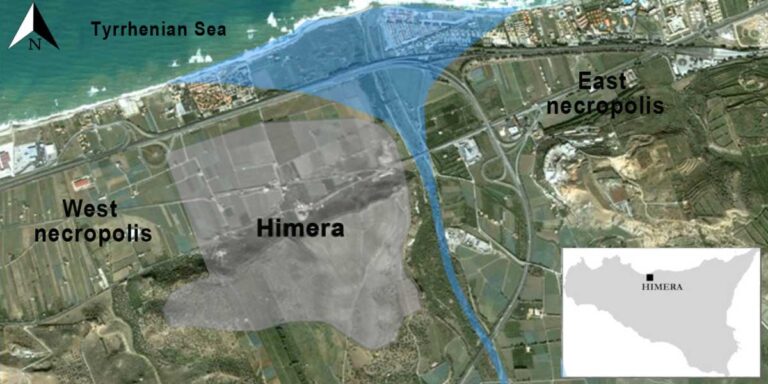
Between the 9th and 3rd centuries BCE, the Greeks founded more than 500 colonies throughout the Mediterranean basin. According to Norma Lonoce, Gianpiero Dalla-Zuanna, Pier Francesco Fabbri, Stefano Vassallo and Irene Barbiera, analysis of a large necropolis of Himera, a Greek colony in Northern Sicily, suggests that this expansion may have been driven by a comparably favorable demographic regime.
The Greek colony of Himera, founded in 648 BCE on the northern coast of Sicily, provides an exceptional opportunity to study Ancient Greek population dynamics and demographic regimes for several reasons. First, since it was abandoned and never repopulated, it offers a remarkably intact necropolis. In the last 50 years, large-scale excavations of the city and surrounding cemeteries have confirmed the absence of urban settlements after the end of the 5th century BCE, as also indicated in the literary sources.
Second, although none of the necropolises have been fully excavated, a very large skeletal sample has been collected: over 13,000 graves are currently being investigated, the majority of which consist of single inhumations. The Himeran sample is one of the largest in the Greek classical world, including the Greek mainland, the surrounding islands and the colonies founded along the Mediterranean coast.
Third, historical sources allow to date the period when the necropolises were used: between the 7th and the 5th century BCE.
Fourth, starting from the end of the 7th century BCE, children under the age of 5 were usually buried in small pots (enchytrismos). Consequently, although the pots inside the necropolises have often been found absent of any human remains, it is still possible to reliably estimate the number of children who died at ages 0‒4 years.
The demographic mystery of the Greek expansion
Our findings on the population dynamics of Himera contribute to a long-standing debate over the demography of ancient Greece, particularly relative to the population growth and expansion that led the Greeks to colonize many coastal areas of the Mediterranean basin (Lonoce, et al 2023). After a period of recession during the so-called Hellenic Middle Ages, a phase of economic and demographic growth began in 9th‒8th century BCE, accompanied by a notable spread of the population. Between the 9th/8th and 4th/3rd centuries BCE, an estimated 500 colonies were founded by the Greeks, first in the eastern and then in the western Mediterranean. Although recent genetic analyses suggest that many of the inhabitants of the new cities founded by the Greeks were actually autochthonous, which diminishes the role played by the “demographic push” of Ancient Greece, the demographic roots of such a strong and lasting expansion remain largely unexplained (Sallares 1991, Scheidel 2003, Morris 2005). The study of Himera may shed some light on this fascinating puzzle.
What a cemetery can tell us about population dynamics
Demographers are skeptical about studying the demographic dynamic of a population by analyzing data from skeletons found in cemeteries. However, if some conditions are met, the age distribution of skeletons can reveal something of the mortality regime of the time, at least between 5 and 60 years of age, even if the precise ages of the deceased aged over 30 are difficult to determine. (Acsadi and Nemeskeri 1970; Steckel et al 2018). The two most important conditions are that the population be at least roughly stationary (number of births similar to that of deaths, no migration and constant age structure) and that the sample of skeletons analyzed be not too distorted by age with respect to the set of all individuals buried. In the West necropolis of Himera, the subject of this study, these conditions are met for all of the city’s last 150 years, when archaeological findings suggest that its population remained relatively constant before its complete destruction. Furthermore, as already mentioned, deceased children in Himera were almost always placed in small pots before being buried, making it possible to estimate mortality at age 0 and at ages 1-4. This is very exceptional for ancient cemeteries, because the fragile bones of children cannot withstand the wear and tear of time. Overall, our data refer to 2,865 individuals for whom it was possible to estimate the age at death.
(Relatively) low mortality of children and youth
For infants and young people, mortality at Himera almost overlaps with that of Woods’ (2007) standard life tables for Ancient Southern Europe with e0=30 (Table 1 and Figure 1). For adults, however, mortality is higher, close to that of Woods’ standard tables with e0=20. This mortality pattern (relatively low under 20 years, and high thereafter) is confirmed by two other types of comparisons.
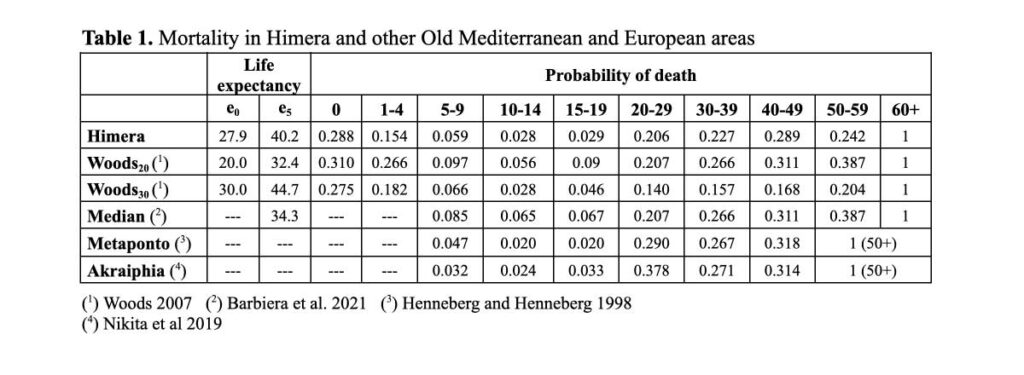
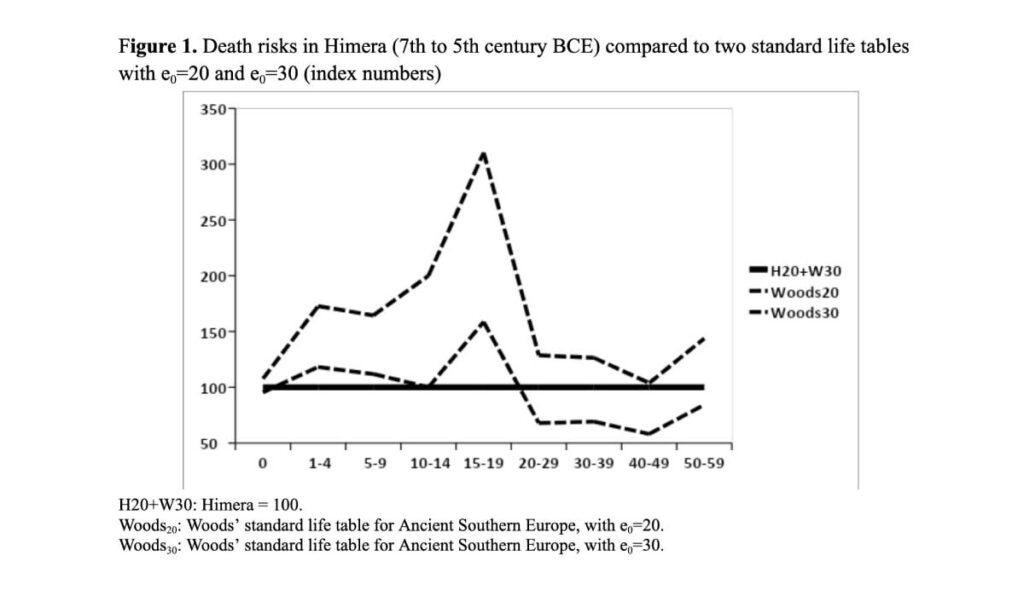
First, Barbiera, Castiglioni and Dalla-Zuanna (2021) collated the data of seventy ancient and medieval pre-1348 European cemeteries (rigorously selected according to high quality data standards), to build standard tables for ages 5‒59, which can be used as a standard of comparison (Table 1 and Figure 2). In Himera, juvenile mortality (ages 5‒19) is below the first quartile (e5=29.4), while adult mortality (ages 20‒59) is close to the median of this set of tables. Comparison with another large set of ancient and medieval European cemeteries (Steckel at al 2018) gives similar results: Himera is characterized by moderate mortality for young people (ages 5‒19) and high mortality for adults (20‒49).
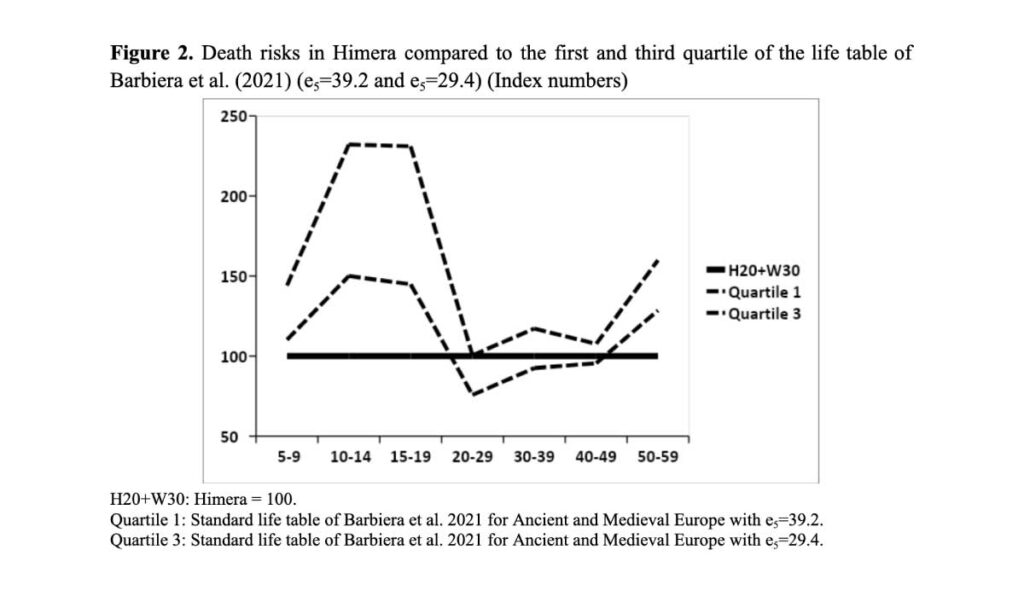
Second, we can consider two other Greek samples where detailed osteological analyses have been conducted, with very high-quality data on age (Table 1 and Figure 3). The first is the Metaponto chora (Matera, Italy), dating from the 6th to 3rd centuries BCE, comprising 277 skeletons (Henneberg and Henneberg 1998), and the second is Akraiphia (Boeotia, Greece), dating from the 7th to 3rd centuries BCE, comprising 135 skeletons (Nikita et al 2019). Juvenile mortality is moderate (lower than in Himera) while adult mortality is higher than in Himera.
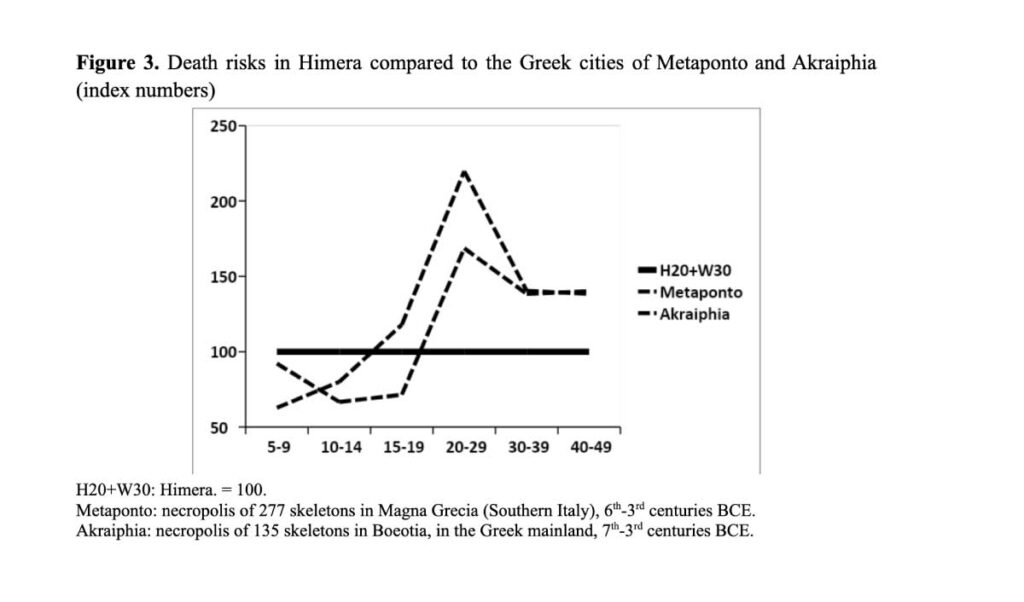
An atypical mortality regime
Our analysis of the western necropolis of Himera reveals a particular mortality regime, resembling that of the two Greek cities of Metaponto and Akraiphia, but differing from that suggested by Barbiera, Castiglioni and Dalla-Zuanna (2021) for Europe during the 1st-14th centuries BCE. Our findings question the widely accepted hypothesis of a high-pressure demographic regime during this period, with life expectancy around 20-25 years and (consequently) birth rates around 40-50 per 1,000. Rather, the available data suggest that between the mid-600s and 409 BCE, the mortality of children and young people in Himera was relatively low, and only partially counterbalanced by more pronounced adult mortality. Accordingly, life expectancy at birth might have been between 25 and 30 years, with death and birth rates around 33 to 40 per 1,000.
Very different demographic regimes likely coexisted across the vast spatial and temporal space occupied for more than half a millennium by the Ancient Greeks. Thus, it would be imprudent to deduce from our results that the spread of the Ancient Greek population was determined solely by relatively low child and youth mortality, resulting in a moderately positive growth rate. Nonetheless, our findings do not rule out the possibility that in a medium to long-term historical perspective, favourable and expansive demographics contributed to the sustained success of the Greek population, together with technological development and military might.
References
Acsadi, G., Nemeskeri, I., 1970. History of Human Life Span and Mortality, Akademiai Kiado, Budapest (HU).
Barbiera, I., Castiglioni, M., Dalla-Zuanna, G., 2021. Standard Life Tables for Western and Southern Europe from Antiquity to the Black Death, Popolazione e Storia. 22(2), 73‒97.
Henneberg , M., Henneberg, R. J., 1998. Biological Characteristics of the Population Based on Analysis of Skeletal Remains, in: Carter, J. C., (Ed.), The Chora of Metaponto: The Necropoleis (2), Austin: University of Texas Press, pp. 503–556.
Lonoce, N. Dalla-Zuanna, G. Fabbri, P.F, Vassallo S., Barbiera, I. (2023) An unexpected demographic regime: The western necropolis of the Greek colony of Himera (Sicily, Italy) (550-409 BCE), Journal of Archaeological Science, 155, July, 105790.
Morris, I., 2005. The Growth of Greek Cities in the First Millennium BC. Princeton/Stanford Working Papers in Classics Paper No. 120509.
Nikita, E., Schrock, C., Sabetai, V., Vlachogianni, E., 2019. Bioarchaeological perspectives to diachronic life quality and mobility in ancient Boeotia, central Greece: Preliminary insights from Akraiphia. Internatonal Journal of Osteoarchaeology. 29, 26‒35.
Sallares, R., 1991. The Ecology of the Ancient Greek World. Ithaca (USA).
Scheidel, W., 2003. The Greek demographic expansion: models and comparisons. Journal of Hellenic Studies 123: 120‒40.
Steckel, R.H., Larsen, C.S., Roberts, A.C. Baten, J., 2018. The Backbone of Europe: Health, Diet, Work and Violence Over Two Millennia, Cambridge University Press, Cambridge (UK).Woods, R., 2007. Ancient and Early Modern Mortality: Experience and Understanding. The Economic History Review, New Series. 60(2), 373‒399.